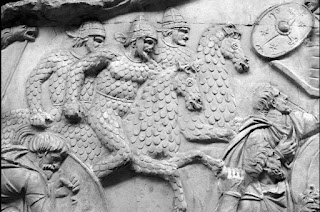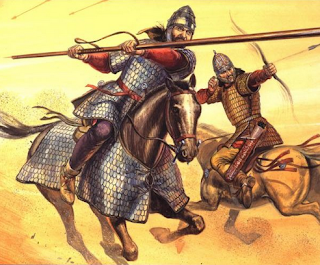Sarmatian Cataphracts From Trajan's Column
Peter Verburgh (personal correspondence) has reminded me that the Ribchester fort of the Sarmatian veterans, which I've recently decided upon as the home and base of the famous 6th century Arthur, is listed among the 'per lineum ualli' in the NOTITIA DIGNITATUM. This is an important classification of Ribchester, as Arthur operated militarily at the Wall just south of Corbridge and at Castlesteads.
I'm quoting here the relevant portion of the N.D.:
Occ. XL:
DUX BRITANNIARUM*
17. Sub dispositione uiri spectabilis ducis Britanniarum:
18. Praefectus legionis sextae
19. Praefectus equitum Dalmatarum, Praesidio
20. Praefectus equitum Crispianorum, Dano
21. Praefectus equitum catafractariorum, Morbio
22. Praefectus numeri barcariorum Tigrisiensium, Arbeia
23. Praefectus numeri Nerviorum Dictensium, Dicti
24. Praefectus numeri uigilum, Concangios
25. Praefectus numeri exploratorum, Lauatres
26. Praefectus numeri directorum, Uerteris
27. Praefectus numeri defensorum, Braboniaco
28. Praefectus numeri Solensium, Maglone
29. Praefectus numeri Pacensium, Magis
30. Praefectus numeri Longovicanorum, Longouico
31. Praefectus numeri superuenientium Petueriensium, Deruentione
32. Item per lineam ualli:
33. Tribunus cohortis quartae Lingonum, Segeduno
34. Tribunus cohortis primae Cornouiorum, Ponte Aeli
35. Praefectus alae primae Asturum, Conderco
36. Tribunus cohortis primae Frixagorum, Uindobala
37. Praefectus alae Sabinianae, Hunno
38. Praefectus alae secundae Asturum, Cilurno
39. Tribunus cohortis primae Batauorum, Procolitia
40. Tribunus cohortis primae Tungrorum, Borcouicio
41. Tribunus cohortis quartae Gallorum, Uindolana
42. Tribunus cohortis primae Asturum, Aesica
43. Tribunus cohortis secundae Dalmatarum, Magnis
44. Tribunus cohortis primae Aeliae Dacorum, Amboglanna
45. Praefectus alae Petrianae, Uxelodunum or Petrianis
46. 'Luguuallii'
47. Praefectus numeri Maurorum Aurelianorum, Aballaba
48. Tribunus cohortis secundae Lingonum, Congauata
49. Tribunus cohortis primae Hispaniorum, Axeloduno
50. Tribunus cohortis secundae Thracum, Gabrosenti
51. Tribunus cohortus primae Aeliae classicae, Tunnocelo
52. Tribunus cohortis primae Morinorum, Glannibanta
53. Tribunus cohortis tertiae Neruiorum, Alione
54. Cuneus Sarmatarum, Bremetenraco [Ribchester]
55. Praefectus alae primae Herculeae, Olenaco
56. Tribunus cohortis sextae Neruiorum, Uirosido
* From
http://www.vortigernstudies.org.uk/artsou/notitialist.htm
Observant readers will notice two things immediately. One, the unit garrisoning Ribchester is referred to as a
cuneus. This distinction is not found
for any other unit in the N.D.
Two, no commander is listed for this cuneus. Again, this is the only instance in the entire text of the N.D. in which a unit commander is omitted.
I will explore the reason for this exception and apparent oversight below. But first, here are the relevant definitions associated with a cuneus:
cuneus (m. pl. cunei)
1. Literally ‘a wedge’, a type of formation in that shape used in battle and countered with the forceps (Fest. s.v.; Veg., DRM 3.19; Aul. Gell. 10.9.1). 2. An irregular auxiliary unit, often mounted (ND Or. XXXIX.1–9. RIB 882; 1594). See also caput porcinum and forceps [Cowan 2007]
caput porci(num) (n. pl. capita porcorum)
Literally ‘pig’s head’, an informal term referring to the battlefield tactic known as the cuneus. Veg., DRM 3.19; Amm. 17.13.9. [Cowan 2007]
forceps (f. pl. forcipes)
Literally ‘pincers’, a battlefield formation used to counter the cuneus by mirroring its shape (centre held back and flanks advanced). Aul. Gell. 10.9.1. See also forfex [Cowan 2007]
forfex (f. pl. forfices)
Literally ‘shears’ or ‘claw’, a battlefield formation used to counter the cuneus by mirroring its shape (centre held back and flanks advanced). Fest. s.v.; Veg., DRM 3.19. See also forceps [Cowan 2007]
- from
https://perlineamvalli.wordpress.com/2018/05/24/the-roman-army-a-to-z-cuneus/
A good description of cunei can be found at:
http://lukeuedasarson.com/Cunei.html
The Sarmatian cuneus would have been composed of somewhere between 200-300 heavy shock troops, so-called "cataphracts", a terms borrowed from the Greek and meaning (from the Lewis and Short Dictionary at PERSEUS):
"I. mailed, in mail (of soldiers and their horses), Sall. ap. Non. p. 556, 16 sq. (id. H. 4, 57 Dietsch).—As subst.: cătă-phracti , ōrum, m., mailed soldiers, Sisenn. ap. Non. 1. 1.: “loricatos, quos cataphractos vocant,” Liv. 35, 48, 3; 37, 40, 5 al.; Prop. 3 (4), 12, 12; Serv. ad Verg. A. 11, 770; Front. Princ. Hist. 5, p. 247 Nieb.; Inscr. Orell. 804."
It was the job of such heavily armored units to smash through enemy lines with a tightly grouped cavalry charge. To quote from Richmond's study of the Sarmatians at Ribchester ("The Sarmatae: Bremetennacum Veteranorum and the Regio Bremetennacensis", THE JOURNAL OF ROMAN STUDIES, Vol. 35, Parts 1 and 2, 1945, pp. 15-29):
"They [the Sarmatians] were remarkably equipped for war, men and horses being clothed from head to foot in mail after the manner of Persian
catafractarii, and carried a heavy spear requiring the use of both hands... It was without doubt these heavy cataphracts whom the Imperial staff, ever anxious to develop their cavalry arm, desired to acquire; for Roman experience had shown that, while the Sarmatian cavalry were at a disadvantage when off their gaurd or hampered by snow or mud, no ranks could withstand their charge in the battle-line. In the Roman service many defects could be cured or remedied by drill and discipline, and it became the view of later Roman military experts that cataphracts rendered the best service both in breaking a battle-line and in pursuing broken infantry."
But why for ONLY the Cuneus Sarmatarum is no commander listed? Well, the answer to that question may be answered here:
"Interestingly, the officer recorded in RIB 583 as commanding the unit is a centurion deputised from Legio VI victrix, so it may be the case that the lack of a (formal?) commanding officer recorded in the Notitia is not an inadvertent scribal omission, but may reflect a more-or-less permanent state of affairs in actuality."
- from
http://lukeuedasarson.com/NDDuxBritCunSarm.html
The inscription the author of that Website is alluding to is to be found at
https://romaninscriptionsofbritain.org/inscriptions/583. It reads:
"To the holy god Apollo Maponus for the welfare of our Lord (the Emperor) and of Gordian's Own Unit of Sarmatian cavalry of Bremetennacum Aelius Antoninus,
centurion of the Sixth Legion Victrix, from Melitene, acting-commander and prefect, fulfilled his vow willingly, deservedly. Dedicated 31 August in the consulship of the Emperor Our Lord Gordian for the second time and of Ponpeianus."
Now, if in the late period (that recorded by the Notitia Dignitatum) a lower-level officer of the Sixth Legion at York was designated as the commander of the Cuneus Sarmatarum, we can postulate an even closer connection between a 6th century Arthur at Ribchester with the memory of the dux (and de facto governor) Lucius Artorius Castus from York.
Finally, if the cuneus of Sarmatian cataphracts were commanded by an officer detached from the Sixth Legion at York, this may have been because this allowed the unit to be used anywhere at anytime - in short, whenever an elite "shock' heavy cavalry was needed to break a battle-line. It goes without saying that the Sixth Legion would have been responsible for determining where and for what reason this force was sent into action.
However, Dr. Benet Salway adds (via personal correspondence):
"As for the cuneus of Sarmatae in Britain, I don’t think you can build anything on the lack of mention of commander. It seems to be consistent scribal practice across the ND (east and west) not to list commanders for cunei (see
http://www.intratext.com/IXT/LAT0212/Y.HTM), even in lists, such as this one, which give commanders for other types of units.
I am not sure what this means for the command structure of cunei."
I'm seeking more information on this subject from experts in the late Roman army and, as always, will post results of my queries here.
UPDATE:
The following was sent to me by Professor Roger Tomlin:
"In Dietrich Hoffmann's great book on the Notitia and the late-Roman army, the author analyses the evolution of cunei from larger cavalry units. It strikes me there isn't much epigraphic evidence of what their commanders were called: I suppose praepositi. For what it's worth, the centurion Aelius Antoninus at Ribchester is said to be praepositus, which you might press to mean acting-commander at that date; and I expect you could find centurions who are acting-commanders of part-mounted cohorts, if not cavalry alae.
I took a quick look at Michael Speidel's Denkmäler, and there are centurions active there, even though the equites singulares were entirely cavalry. And what about No. 27, an altar dedicated by Ulpius Marcellus ex decurione factus (centurio)? I think we should be cautious about thinking cavalry and infantry careers were entirely distinct. After all, every equestrian prefect of an ala in the early Empire had previously commanded an infantry cohort."


















